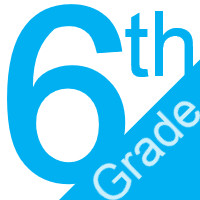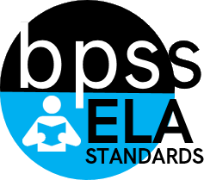6th Grade English
 Standards Glossaries
Standards Glossaries
| K Grade English | 1st Grade English | 2nd Grade English |
 Standards Glossaries
Standards Glossaries
| 3rd Grade English | 4th Grade English | 5th Grade English |
 Standards Glossaries
Standards Glossaries
| 6th Grade English | 7th Grade English | 8th Grade English |
 Standards Glossaries
Standards Glossaries
| 9th Grade English | 10th Grade English | 11th Grade English | 12th Grade English |
 Standards Glossaries
Standards Glossaries
| HS Journalism | HS Speech |
| Prioritized Benchmarks |
ELA-06.L.01
Student Learning Targets for 6th Grade English:Knowledge Targets
Reasoning Targets
Skills (Performance) Targets
| ||||||||||||||||||||||||||||||||||||||||
| Score | 6.L.01 Demonstrate command of the conventions of standard English grammar and usage when writing or speaking. | Sample Activity |
|
| 4.0 | In addition to Score 3.0, the student is able to demonstrate correct usage of pronouns independently and is able to identify pronoun type without prompting. | ||
| 3.5 | In addition to Score 3.0 performance, the student demonstrates in-depth inferences and applications regarding the more complex content with partial success. | ||
| 3.0 |
“The Standard.” The student:
The student exhibits no major errors or omissions. |
|
|
| 2.5 | The student demonstrates no major errors or omissions regarding the simpler details and processes (Score 2.0 content) and partial knowledge of the more complex ideas and processes (Score 3.0 content). | ||
| 2.0 |
There are no major errors or omissions regarding the simpler details and processes as the student:
However, the student exhibits major errors or omissions regarding the more complex ideas and processes. (For example on questions 5-7, if they recognize the correct pronoun but can not identify its type.) |
- | |
| 1.5 | The student demonstrates partial knowledge of the simpler details and processes (Score 2.0 content) but exhibits major errors or omissions regarding the more complex ideas and procedures (Score 3.0 content). | ||
| 1.0 | With help, the student demonstrates a partial understanding of some of the simpler details and processes (Score 2.0 content) and some of the more complex ideas and processes (Score 3.0 content). | ||
| 0.5 | With help, the student demonstrates a partial understanding of some of the simpler details and processes (Score 2.0 content) but not the more complex ideas and processes (Score 3.0 content). | ||
Resources:
Websites
www.funbrain.com
www.quizlet.com
easygrammar4kids/pronouns
Vocabulary
intensive pronouns
subjective pronouns
objective pronouns
possessive pronouns
reflexive pronouns
antecedent
indefinite pronouns
ELA-06.L.02
Student Learning TargetsKnowledge Targets
Reasoning Targets
Skills (Performance) Targets
Product Targets
Proficiency Scale:
Resources:WebsitesWhen searching for help, google "capitalization, spelling, and punctuation" Owl - a Little Help with Capitals Vocabulary
| ||||||||||||||||||||||||||||||||||||||||
ELA-06.L.04
Student Learning Targets for 6th Grade English:Knowledge Targets
Reasoning Targets
Skills (Performance) Targets
Product Targets
Proficiency Scale
ResourcesWebsiteswww.dictionary.com www.merriam-webster.com (vocabulary games and practices quizes) Vocabularysuffix root/base word prefix dictionary thesauruses glossaries
| ||||||||||||||||||||||||||||||||||||||||
ELA-06.L.05
Student Learning Targets: for Grade 6 English:Knowledge Targets
Reasoning Targets
Skills (Performance) Targets
Product Targets
Proficiency Scale
ResourcesWebsiteswww.funbrain.com www.globalclassroom.org google search "figurative language" Vocabularyalliteration idiom simile metaphor personification onomatopoeia hyperbole irony pun connotation denotation nuances word analogies
| ||||||||||||||||||||||||||||||||||||||||
ELA-06.RI
Narrative for (RI) Reading InformationIn grade 6, the North Dakota State Standards call for students to proficiently read grade-appropriate complex informational texts while further developing the ability to cite textual evidence to support their conclusions regarding key ideas and claims. While learning about an author’s point of view, students also examine how authors use reasons to make their points and support arguments with evidence, separating unsupported assertions from those backed by evidence. Students also look at how structure and content contribute to the development of ideas. Reading informative texts has not lessened the focus on reading literature in the English classroom; instead, this reading strand is to be viewed as a shared responsibility with other content areas such as science and social studies. Focusing on how authors make their points and support their arguments with evidence and reasoning helps 6th grade students sharpen their ability to write and speak with more clarity and coherence in all content arenas. Calculation Method for StrandsStrands are larger groups of related standards. The Strand Grade is a calculation of all the related standards. Click on the standard name below each strand to access the learning targets and proficiency scales for each strand's related standards. | |
ELA-06.RI.01
ELA-06.RI.01 Read closely to comprehend Informational/Nonfiction text.Sub-Standards:
a. Cite textual evidence to support analysis of what the text says explicitly.
b. Cite textual evidence to support inferences drawn from the text.
c. Provide a summary of the text excluding personal opinions or judgments.
Student Learning Targets:Knowledge Targets
Reasoning Targets
Skills (Performance) Targets
Proficiency ScaleThe student can ...1 Beginning... with help, demonstrates a partial understanding of some of the simpler details and processes (Score 2.0 content) and some of the more complex ideas and processes (Score 3.0 content).Start 2 Developing... demonstrates no major errors or omissions regarding the simpler details and processes but exhibits major errors or omissions regarding the more complex ideas and processes (Score 3.0 content).Simple 3 Proficient“The Standard.”... demonstrates no major errors or omissions regarding any of the information and processes that were end of instruction expectations. Target 4 Advanced... demonstrates in-depth inferences and applications regarding more complex material that go beyond end of instruction expectations.Complex Proficiency Scale
To view the Middle School Read Right Rubric click here. ResourcesVocabulary
Websites
| |||||||||||||||||||||||||||||||||||||||
ELA-06.RI.01.a
ELA-06.RI.01 Read closely to comprehend Informational/Nonfiction text.
Proficiency ScaleThe student can ...1 Beginning... with help, demonstrates a partial understanding of some of the simpler details and processes (Score 2.0 content) and some of the more complex ideas and processes (Score 3.0 content).Start 2 Developing... demonstrates no major errors or omissions regarding the simpler details and processes but exhibits major errors or omissions regarding the more complex ideas and processes (Score 3.0 content).Simple 3 Proficient“The Standard.”... demonstrates no major errors or omissions regarding any of the information and processes that were end of instruction expectations. Target 4 Advanced... demonstrates in-depth inferences and applications regarding more complex material that go beyond end of instruction expectations.Complex | |
ELA-06.RI.01.b
ELA-06.RI.01 Read closely to comprehend Informational/Nonfiction text.
Proficiency ScaleThe student can ...1 Beginning... with help, demonstrates a partial understanding of some of the simpler details and processes (Score 2.0 content) and some of the more complex ideas and processes (Score 3.0 content).Start 2 Developing... demonstrates no major errors or omissions regarding the simpler details and processes but exhibits major errors or omissions regarding the more complex ideas and processes (Score 3.0 content).Simple 3 Proficient“The Standard.”... demonstrates no major errors or omissions regarding any of the information and processes that were end of instruction expectations. Target 4 Advanced... demonstrates in-depth inferences and applications regarding more complex material that go beyond end of instruction expectations.Complex | |
ELA-06.RI.01.c
ELA-06.RI.01 Read closely to comprehend Informational/Nonfiction text.
Proficiency ScaleThe student can ...1 Beginning... with help, demonstrates a partial understanding of some of the simpler details and processes (Score 2.0 content) and some of the more complex ideas and processes (Score 3.0 content).Start 2 Developing... demonstrates no major errors or omissions regarding the simpler details and processes but exhibits major errors or omissions regarding the more complex ideas and processes (Score 3.0 content).Simple 3 Proficient“The Standard.”... demonstrates no major errors or omissions regarding any of the information and processes that were end of instruction expectations. Target 4 Advanced... demonstrates in-depth inferences and applications regarding more complex material that go beyond end of instruction expectations.Complex | |
ELA-06.RI.02
ELA-06.RI.02 Determine a central idea of a text and explain how it is conveyed through particular details.Student Learning Targets:Knowledge Targets
Reasoning Targets
Skills (Performance) Targets
Proficiency ScaleThe student can ...1 Beginning... with help, demonstrates a partial understanding of some of the simpler details and processes (Score 2.0 content) and some of the more complex ideas and processes (Score 3.0 content).Start 2 Developing... demonstrates no major errors or omissions regarding the simpler details and processes but exhibits major errors or omissions regarding the more complex ideas and processes (Score 3.0 content).Simple 3 Proficient“The Standard.”... demonstrates no major errors or omissions regarding any of the information and processes that were end of instruction expectations. Target 4 Advanced... demonstrates in-depth inferences and applications regarding more complex material that go beyond end of instruction expectations.Complex Proficiency Scale
ResourcesVocabulary
Websites
| |||||||||||||||||||||||||||||||||||||||
ELA-06.RI.06
Student Learning Targets:Knowledge Targets
Reasoning Targets
Skills (Performance) Targets
Product Targets
Proficiency Scale
ResourcesWebsites Vocabulary | ||||||||||||||||||||||||||||||||||||||||




 Strand (RI)
Strand (RI)